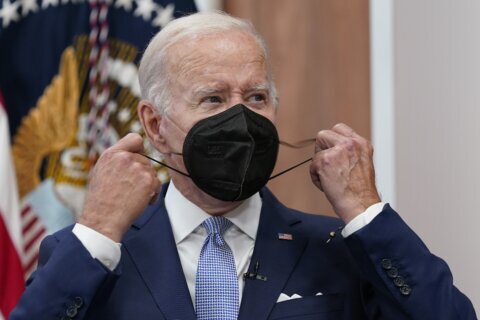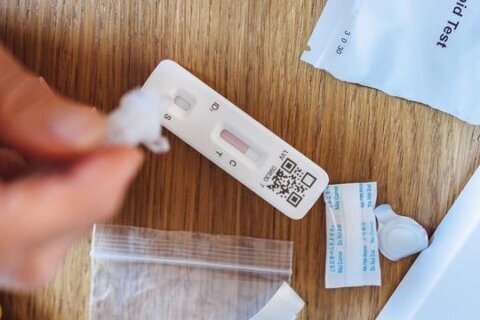The numbers of daily new reported coronavirus cases appear to be dropping in most states as the majority of the country takes steps to open their economies — though there are plenty of caveats.
Below, we’ll examine which states’ daily rates are rising or falling the steepest in relation to each other. Because this involves ranking states, we’ve adjusted for population.
First, a word on how case rates may, or may not, be important. Some public health experts say declining case rates should be one guide for figuring when states should relax social distancing restrictions.
On the other hand, uneven testing rates should affect how states’ positive case rates rise and fall. For example, case rates may rise as testing rates increase.
But even then, many public health experts say, states still aren’t testing enough, so even if they’ve recently ramped it up, they still might not be capturing an accurate picture.
“I am not ready at all to breathe a sigh of relief,” Dr. Jeanne Marrazzo, director of the division of infectious diseases at University of Alabama at Birmingham, told CNN’s “New Day” on Friday about the apparent decline in some states’ case rates.
One reason: “How many people are being tested? Are we getting a really accurate estimate?” she asked. And experts have warned of more waves ahead as social restrictions relax.
Having said that, here are the states with the largest changes in seven-day, average daily case rates over the past week.
Maps and charts: See daily new cases for each state in the past 14 days
3 states with cases falling fastest
NEW JERSEY
This appears to be relatively bright news for hard-hit New Jersey, second in the country only to New York for the number of total reported cases (143,600+) and deaths (10,100+).
New cases per 100,000 people dropped almost 38% this past week, from 25 cases per 100,000 to about 16.
The state has had one of the more strict and longest-enduring stay-at-home orders. One of the few nonessential things to open there were parks and golf courses. Nonessential construction and curbside retail pickup can reopen Monday, while ocean and lakefront beaches could reopen with limits on May 22.
MISSOURI
New cases per 100,000 people dropped about 35% this past week, from nearly 4 cases per 100,000 to 2.6.
This state generally began allowing all businesses to reopen May 4, provided they could abide by certain social distancing guidelines. Indoor retail businesses must limit their number of customers to no more than 25% of normal capacity, and local communities can choose stricter rules if they choose.
IDAHO
New cases per 100,000 people dropped nearly 35% this past week, from roughly 1.6 cases per 100,000 to 1.1.
Idaho’s stay-at-home order expired May 1, and most businesses were allowed to open, with restrictions for distancing and sanitation.
More will open soon: Starting Saturday, restaurants can open for dine-in with certain protocols. Indoor gyms, recreation facilities, hair salons and other close contact services also can open with restrictions.
A note of transparency: Vermont and Alaska technically belong on this list. They had the largest (54%) and third-largest (35%) declines in new cases per 100,000 people this past week.
But they already started with small amounts of new cases, and any change was going to look outsize. To highlight a state here, we required they started last week with at least roughly two new cases per 100,000. Vermont and Alaska had less than one.
3 states with cases rising fastest
SOUTH DAKOTA
New cases per 100,000 people jumped 134% this past week, from nearly seven cases per 100,000 to about 15.
The state reported an unusually high two-day spike in tests late last week, according to the COVID Tracking Project, though it’s not clear to what extent that contributed to the spike.
State officials intend to intensify testing. Starting next week, all residents of nursing homes and assisted living facilities, as well as staff members, will be tested, state health department Secretary Kim Malsam-Rysdon said Thursday.
South Dakota has a relatively few 3,800 cases, but with less than 1 million people, it’s in the country’s top 20 states for cases per 100,000 people.
“We’re watching (the virus) march further and further west to less populated states, and even less populated states are seeing a caseload,” Maureen Miller, infectious disease epidemiologist at Columbia University, told “New Day” Friday, without specifically referring to South Dakota. “So that is how the wave works. It’s going to bubble up in different places over time.”
ARKANSAS
New cases per 100,000 people increased almost 50% this past week, from about two cases per 100,000 to roughly three.
The state started reopening some businesses May 4, and starting this week restaurants were allowed to let diners inside — as long as they operate a a third of their normal capacity.
Waves of infection have been hitting the country at different times, said Marrazzo of UAB. New York may be declining because it was already very hard hit, “but if you go into a place that hasn’t really experienced their upswing yet, you’re going to see a very different pattern,” she said, though she did not specifically address Arkansas.
MAINE
New cases per 100,000 people rose nearly 32% this past week, from 2.1 cases per 100,000 to 2.8.
Maine is under a stay-at-home order through at least May 31, though certain types of businesses have been reopening, starting May 1.
One to watch: Georgia
Georgia made some of the earliest and most extensive moves to loosen restrictions.
Gyms, fitness centers, bowling alleys, body art studios, hair and nail salons and massage therapists were able to reopen April 24, with certain rules. Other businesses followed later.
A shelter-in-place order ended April 30, except for “medically fragile and elderly Georgians,” who generally must stay home until June 12.
The state’s case rates have appeared steady, even three weeks after those first reopening steps.
This week, the state ranked near the middle of country’s pack. Its reported cases decreased by about 6% this week — from nearly seven cases per 100,000 to around six.
Maureen Miller, an infectious disease epidemiologist at Columbia University, said she still suspects that “cases are simmering right now,” and it’s still possible hospitalizations and deaths could increase in the next few weeks because of the loosened restrictions.
But there is “not the amount of testing that would be required to ensure that we know what’s going on” in Georgia, she told “New Day” on Friday.
Just because businesses are allowed to open doesn’t mean all are doing so, and “just because things are open doesn’t mean (everyone) is going out,” CNN Chief Medical Correspondent Dr. Sanjay Gupta said Friday, citing what he’s seen where he lives in the Atlanta area.
“I think you just got to wait a little bit longer and make sure these trends continue,” he said.
Gov. Brian Kemp said May 7 that the state had doubled its testing capacity from what it was weeks earlier. He said Thursday that testing was now available for all Georgians, regardless of whether they had symptoms, and that they could contact their local sate health department branch to get scheduled.







